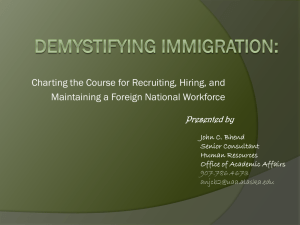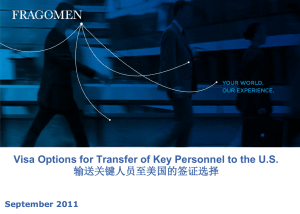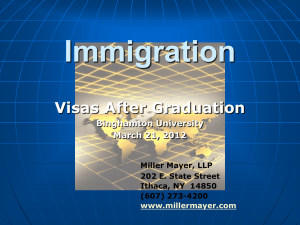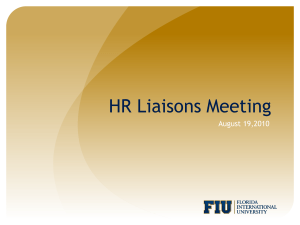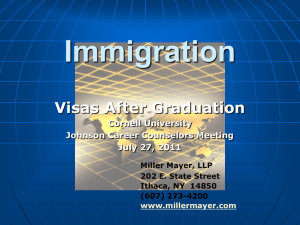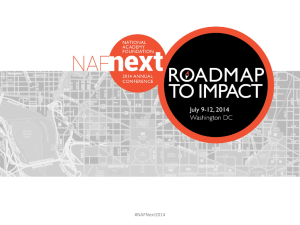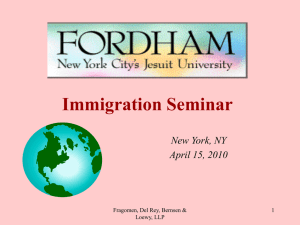Fragomen, Del Rey, Bernsen & Loewy, LLP PowerPoint Presentation
advertisement
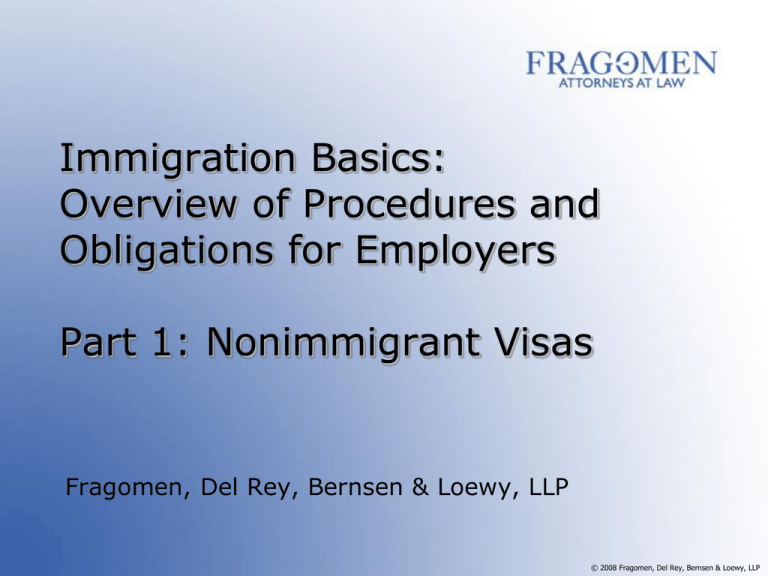
Immigration Basics: Overview of Procedures and Obligations for Employers Part 1: Nonimmigrant Visas Fragomen, Del Rey, Bernsen & Loewy, LLP © 2008 Fragomen, Del Rey, Bernsen & Loewy, LLP Aaron Blumberg ablumberg@fragomen.com Associate Enrique Gonzalez egonzalez@fragomen.com Managing Partner Fragomen, Del Rey, Bernsen & Loewy, LLP 1 Alhambra Plaza, Suite 600, Coral Gables, FL (305) 774-5800 2 Immigration Overview © 2008 Fragomen, Del Rey, Bernsen & Loewy, LLP Three Groups of People in the US 1) Citizens 2) Immigrants 3) Nonimmigrants 4 Nonimmigrants • Coming to the U.S. temporarily • Retain residence abroad • Dual intent - only for H’s and L’s • “Alphabet Soup” - A-V • Important Visas to Know: H-1B, TN, E3, F-1, J-1, O-1 • Immigrants vs. nonimmigrants 5 Immigrants • “Green card holders” = “permanent residents” = “immigrants” • Coming to U.S. permanently • Numerically limited – Visa bulletin – Priority date • Can become U.S. citizens after 3 - 5 years 6 Understanding the Documents © 2008 Fragomen, Del Rey, Bernsen & Loewy, LLP Visa Stamp 8 I-94 (D/S) 9 I-94 (Expiration Date) 10 I-797 Approval Notice & I94 Card 11 I-20 (F) 12 DS-2019 (J) 13 Form I-9 14 H-1B Work Visa © 2008 Fragomen, Del Rey, Bernsen & Loewy, LLP H-1B Category: USCIS Provisions • H-1B visas are for temporary (nonimmigrant) workers engaged in a specialty occupation that requires – (1) theoretical and practical application of highly specialized knowledge and – (2) attainment of a bachelor's or higher degree, or equivalent experience, in the specific specialty for entry into the occupation. • “Specialty Occupation” -- Entry level requirement = minimum Bachelor Degree or equivalent • Cap: 65,000 + 20,000 additional visas allocated to holders of advanced degrees from U.S. universities • Cap Subject vs. Cap Exempt – All Universities are cap exempt 16 H-1B (continued) • H-1B can be full-time or part-time • H-1B workers are “tied” to their employer – Cannot accept payment from any other source • Can hold dual/concurrent H-1Bs with multiple employers • What are the government fees? ($325, $500, $750/$1500) – Universities exempt from Training Fee ($750/$1500) 17 H-1B (continued) • H-1B visas are valid for 3 years and can be extended for an additional 3 year period for a total of 6 years in H-1 status – Previous stays in L-1 or H-1 status (but not L-2 or H-4 dependent status) count towards maximum period of stay – Time spent outside of the US does not count towards 6 year limit • H-1B visas can be extended past the 6-year maximum in certain situations: – 1 year Extension: If PERM has been filed at least 365 days prior to the date the H‐1B expires – 3 year Extension: If an I‐140 has been approved, and the individual cannot adjust status because priority date is not current (usually someone from China or India) 18 Wage Requirements • Actual Wage – paid by the employer to US workers – in the same position – at the same work site – with similar experience and qualifications • Prevailing Wage – Average salary paid to all similarly situated employees (i.e. similar job duties, experience, education, etc.) in each geographic region • Required Wage – higher of the actual or prevailing 19 Prevailing Wages • Two ways to get PWD: Through Dept of Labor OR through FLC Data Center (website) • DOL Wages: DOL will issue a wage by going on FLC Data Center themselves and finding the appropriate job code and wage level • When we get the wage on our own, we run the risk of creating liability for the University, therefore all wages must be obtained through DOL; this creates a Safe Harbor! 20 21 22 23 24 25 Actual Wage Memo & Form • Should be completed and submitted along with NIV employer questionnaire • We need to demonstrate that the University is paying H-1B employees at least, if not more, than all other similarly situated employees 26 University Actual Wage Form ase complete this form for all others in the Department/Division/Center with the same classification as the H-1B employee. Name Employee ID # Title Date Started at University Manny Delcarmen 658-92-673 Computer Programmer 08/01/2007 Bruce Hurst 874-23-001 Computer Programmer John Valentin 876-21-932 Jose Offerman Troy O’Leary Date Started in New Position Contract Length 9/12 Annual Salary Highest Degree Year Degree Earned Institution where Highest Degree Earned N/A 12 $43,000 BS 2007 Florida International University 01/06/2002 1/09/2009 12 $88,000 Masters 1992 University of Miami Computer Programmer 08/20/2009 N/A 12 $52,000 BS 1998 Emory University 653-23-123 Computer Programmer 08/23/2000 8/28/2001 12 $32,000 AA 1999 Miami Dade College 542-22-122 Computer Systems Analyst 01/19/2009 N/A 12 BA 2008 Florida International University $48,200 e salary of the prospective/current H-1B employee has been determined by comparing the education, experience, specialized knowledge and other relevant factors with those for other persons in the same job classification within the Department/Division/Center. partment/Division/Center Chair/Director 27 Printed Name and Title Date MEMORANDUM To: Public Access File From: Kenneth G. Furton, Dean of the College of Arts & Sciences Re: Actual Wage Memorandum for Manny Delcarmen Date: August 19, 2010 As indicated by the attached Actual Wage Form, in addition to Manny Delcarmen, there are three other Computer Programmers in the College of Arts & Sciences. Two of those employees earn a higher salary as they both have more years of experience in the field and one of them holds a Master’s Degree. The reason that Manny Delcarmen’s salary is lower is because he just recently obtained his Bachelor’s Degree and has only 1 year of work experience. 28 Procedural Requirements of the LCA 29 • The U.S. employer must file a Labor Condition Application (LCA) with the Department of Labor. The employer must attest to certain things in the LCA, such as paying the FN at or above the prevailing wage for the position. • U.S. employer must post the LCA for ten business days in two conspicuous locations and include the LCA and other documentation in a public access file. General Requirements of LCA • LCA required for every H-1B petition and all H1B1 & E-3 applications • Purpose – to protect wages and working conditions of U.S. workers • Employer makes attestations on LCA • 10 day posting requirement at work site (2 locations) • LCA form filed electronically with DOL 30 LCA Attestations • All employers must attest: – Working conditions of U.S. workers will not be adversely affected – There is no strike or lockout – H-1B workers will be paid the higher of the prevailing or actual wage – Notice has been provided to all employees 31 Public Access File (PAF) • To be maintained by employer • For every LCA • Retain for 1 year from expiration of LCA or withdrawal of LCA • Must be available for inspection by anyone • Must be created within one working day after the filing of the LCA 32 Additional H-1B Issues © 2008 Fragomen, Del Rey, Bernsen & Loewy, LLP H-1B Dependents • H-4: Spouse and children (under 21) • Status contingent on H-1B • No employment; can study full-time • H-4 children who turn 21 need to change status 34 Premium Processing • USCIS Processing Times: 3-5 months • USCIS Premium Processing Fee = $1225 • Premium Processing = 15 calendar days 35 When is Premium Processing NOT Needed? • Premium Processing is usually not needed for a change of employer or extension of H-1B status – Unless there are immediate travel needs • Change of Employer = Employee is currently working for another employer in H-1B status • Extension of Status: As long as the extension petition is filed BEFORE the current H-1B expires, the employee is authorized to work pursuant to their receipt notice for up to 240 days 36 When is Premium Processing Sometimes Needed? • Change of Status: Most common is changing from F-1 or J-1 to H-1B; employee cannot start working until petition is APPROVED • Consular Notification: When the employee is abroad – Please factor in added delays such as scheduling a visa appointment and getting the visa stamp • Travel: When the foreign national wants an immediate approval in order to be able to travel internationally 37 No “Benching” H-1B Workers • Must start payroll when H-1B “enters into employment”, i.e., when he/she first makes him/herself available for work or comes under control of employer but no later than – 30 days after entering US or – If in US, 60 days after start date on petition or change of status by USCIS, whichever is later • No exception where awaiting license • No unpaid status due to lack of work • Unpaid leave OK if: – H-1B unable to work – Worker’s voluntary request 38 H-1B Portability • Enables nonimmigrants currently in H-1B status to begin new employment upon USCIS receipt of an H-1B petition by new employer. Though there is no official guidance, time from termination of earlier employment to filing of new petition should be minimal (usually less than 30 days). • Eligibility Requirements – Must have been lawfully admitted into the U.S – No unauthorized employment subsequent to lawful admission – Non-frivolous H-1B petition must be filed for new employment before expiration of current status • Don’t forget – porting from cap-exempt nonprofit to a for-profit employer means that the foreign national is submit to the H-1B cap. 39 Terminated H-1B Employees • When are they out of status? Is there a “grace period?” – Technically out of status upon last day of actual productive employment – In practice, USCIS provides “reasonable time” to file change of status or new employer petition after termination of employment – Is changing to B-2 status an option? – Employers must offer to pay principal’s transportation costs home (preferably in writing at the time of termination) • Need to send a withdrawal letter to USCIS immediately! 40 Offering Jobs to Potential H-1Bs • Make it clear that the job offer is contingent upon obtaining valid work authorization • Just because they work for you on OPT does not mean they are necessarily eligible for H1B • H-1B prevailing wages have increased significantly this year • H-1B denials have increased as well 41 Travel Considerations • In order to enter the US in H-1B status, the foreign national must present a valid, unexpired H-1B visa stamp • In order to obtain the visa stamp, foreign nationals must complete an online application form (DS160), make an appointment at their local Embassy/Consulate and present their original I797 approval notice and a copy of the application package we filed with USCIS • Exception: Certain foreign nationals may be able to travel to Canada or Mexico for under 30 days without having an unexpired H-1B visa stamp 42 Other H-1B Issues • H-1B’s can take classes which are “incidental” to his/her employment (part-time studies) • Amendments: Is it a “material change”? – Change in job duties, responsibilities and title are good indicators that an amendment is needed • 212(e): Certain J-1 exchange visitors are subject to a 2 year home-residence requirement; such individuals cannot change status to H-1B until they serve the 2 years at home or obtain a waiver 43 Other Temporary Work Visas © 2008 Fragomen, Del Rey, Bernsen & Loewy, LLP E-3 Visa for Australian Nationals • Visa category for citizens of Australia to take up professional positions in the U.S. – 10,500 per year available • Job offered must be for a “specialty occupation” as defined for H-1B visa category • Requires certified LCA • Visas can be applied for at consulates without prior USCIS approval • Filings can be submitted to USCIS, but premium processing is not available • 2-year validity; renewable indefinitely • Dependent spouses may apply for employment authorization 45 TN Category for Canadian and Mexican Professionals • Must be nationals of either Canada or Mexico • Coming to U.S. to work in profession listed on NAFTA schedule • Generally require a Bachelors degree in field • Canadians apply at border (non-national dependents must obtain visa at U.S. Consulate) • Mexicans apply at Consulate • Three year stay, renewable indefinitely • Extensions and changes of status may be filed at USCIS Service Center • Employer Specific; can hold dual TN’s 46 O-1 Individuals with Extraordinary Ability or Achievement • The O-1 nonimmigrant visa is for the individual who possesses extraordinary ability in the sciences, arts, education, business, or athletics • To qualify for an O-1 visa, the beneficiary must demonstrate extraordinary ability by sustained national or international acclaim and must be coming temporarily to the United States to continue work in the area of extraordinary ability. • Employer specific; but can hold dual O-1s • Anyone still subject to INA 212e (J-1 2 year home residence requirement) can obtain an O-1 visa • 3 years at a time, renewable indefinitely 47 Evidentiary Criteria for O-1 • Evidence that the beneficiary has received a major, internationally-recognized award, such as a Nobel Prize, or evidence of at least (3) three of the following: – Receipt of nationally or internationally recognized prizes or awards for excellence in the field of endeavor – Membership in associations in the field for which classification is sought which require outstanding achievements, as judged by recognized national or international experts in the field – Published material in professional or major trade publications, newspapers or other major media about the beneficiary and the beneficiary’s work in the field for which classification is sought – Original scientific, scholarly, or business-related contributions of major significance in the field – Authorship of scholarly articles in professional journals or other major media in the field for which classification is sought – A high salary or other remuneration for services as evidenced by contracts or other reliable evidence – Participation on a panel, or individually, as a judge of the work of others in the same or in a field of specialization allied to that field for which classification is sought – Employment in a critical or essential capacity for organizations and establishments that have a distinguished reputation 48 F-1 Student Workers • Six employment programs for F-1’s: – On campus – Severe Economic Hardship – Special Student Relief – Internship with international organization – Curricular Practical Training – Optional Practical Training 49 F-1 Curricular Practical Training (CPT) • Integral part of established curriculum – Need letter from school – School endorsed I-20 (issued via SEVIS System) – Can be internship, practicum, coop, work/study, or similar program • Attended ICE approved school for full academic year in any nonimmigrant status; certain grad students may begin immediately • Available part-time or full-time • One year or more of full-time CPT makes you ineligible for OPT at that educational level – But 24 months of part-time CPT is OK! 50 F-1 Optional Practical Training (OPT) • “Optional Practical Training:” pre- or post-graduation – Total = 12 months; part-time during school year, full-time during vacations and after graduation – Need employment authorization document (EAD); – Not tied to particular employer – Employment related to degree program • One year of full-time OPT for each academic level (Associate’s, Bachelor’s, Master’s, Professional, PhD). OPT can’t be “saved” for future degree programs; very hard to cancel after card received • Can have up to 90 days of unemployment • Can use OPT for Assistant Professor positions 51 STEM OPT Extension • Student’s who majored in certain STEM (Science, Technology, Engineering, Math) fields may be eligible for a 17 month extension of work authorization • BUT, must have a job offer from a company that is enrolled in E-Verify • Allowed to have up to 120 days of unemployment • Must file I-765 with USCIS BEFORE current OPT expires (and preferably 120 days before expiration) • Students CAN work with an expired OPT card when a timely filed STEM extension application is pending with USCIS 52 J-1 Exchange Visitors • Categories include trainees, interns, research scholars, specialists, students, au pairs, etc. • Some J’s must return to home country for 2 years after completion of program or seek waiver – skills list – government funding – graduate medical education 53 J-1 Students (Academic Training) • Similar to F-1 OPT (work must be related to major) • Can be used while in school or post-graduation • 18 months max for undergrads and pre-docs (unless course of study is less than 18 months long) • 36 months max for post-docs (unless course of study is less than 36 months) • Need letter from RO/ARO and valid DS2019/I-94 for I-9 purposes 54 J-1 Scholars and Professors • 5 year maximum (no recapture); employment tied to sponsor; no wage requirements • Cannot be in a tenured or tenure-track position • 12 Month Bar: Can’t get this particular J-1 if EV was in J-1/J-2 status within the past 12 months (several exceptions apply) • 24 Month Bar: Can’t get this particular J-1 if EV was in J-1/J-2 status (as a Scholar or Professor) within the past 24 months • 2 Year Home Residence Requirement: Additional restriction 55 B-1 Visitor for Business • Cannot receive pay from a US source • Admitted for up to 6 months (90 days for Visa Waiver) • Must show that temporary activity in US will not be considered productive employment for a US company • Common Uses: Independent research, conferences, training, lecture, meeting • 9, 6, 5 Rule: If honorarium will be received, activities can last no longer than nine days at any single institution or organization; honorarium is for services conducted for the benefit of the institution or entity; and visa applicant will not have accepted such payment or expenses from more than five institutions or organizations over the last six months. • B-1 vs. J-1 56 Initiating A Case © 2008 Fragomen, Del Rey, Bernsen & Loewy, LLP The IHP (Immigration Home Page) • The Dept must obtain authorization from HR to proceed with the sponsorship • The Dept and/or HR MUST initiate a case online on the IHP (https://nsu.fdbl.com/) by completing the “Nonimmigrant Visa Employer Questionnaire” 58 • Once we get the employer questionnaire, we contact the employee to complete the employee questionnaire • We cannot begin working on a case until we have the completed Employer and Employee questionnaires. 59 When Should I Initiate a Case? • THE EARLIER THE BETTER! • Recommended: Initiate Cases 6-8 months in advance 60 Permanent Residence Overview © 2008 Fragomen, Del Rey, Bernsen & Loewy, LLP How to Get a Green Card • Family • Work • Diversity Lottery • Asylum • Special Legislation 62 Diversity Lottery • 50,000 green cards given out each year (about 14 million applicants) • Odds of winning the powerball jackpot?? 1 in 195,249,054 • Who is NOT eligible? BRAZIL, CANADA, CHINA (mainlandborn), COLOMBIA, DOMINICAN REPUBLIC, ECUADOR, EL SALVADOR, GUATEMALA, HAITI, INDIA, JAMAICA, MEXICO, PAKISTAN, PERU, PHILIPPINES, POLAND, SOUTH KOREA, UNITED KINGDOM (except Northern Ireland) and its dependent territories, and VIETNAM • Persons born in Hong Kong SAR, Macau SAR, and Taiwan are eligible. 63 Family Based Permanent Residence • Immediate relatives (spouses, minor children & parents of U.S. citizens) • Other close family members of citizens or permanent residents, including: 1. Unmarried sons & daughters of citizens (over age 21) 2. Spouses & children of LPRs (2A) & unmarried sons/daughters of LPRs (2B) 3. Married sons & daughters of citizens 4. Brothers & sisters of citizens 64 May 2011 Family Bulletin 65 Employment-Based Categories • EB-1: Priority workers • EB-2: Advance-degree professionals & aliens of exceptional ability* • EB-3: Professional, skilled & unskilled workers* (* labor certification required) 66 May 2011 Employment Bulletin 67 Priority Workers & National Interest Waivers © 2008 Fragomen, Del Rey, Bernsen & Loewy, LLP EB-1 Outstanding Researchers/Professors • You must demonstrate international recognition for your outstanding achievements in a particular academic field. • You must have at least 3 years experience in teaching or research in that academic area. • You must be entering the United States in order to pursue tenure or tenure track teaching or comparable research position at a university or other institution of higher education. 69 EB-1 Outstanding Researchers/Professors • Evidence of receipt of major prizes or awards for outstanding achievement • Evidence of membership in associations that require their members to demonstrate outstanding achievement • Evidence of published material in professional publications written by others about the alien's work in the academic field • Evidence of participation, either on a panel or individually, as a judge of the work of others in the same or allied academic field • Evidence of original scientific or scholarly research contributions in the field • Evidence of authorship of scholarly books or articles (in scholarly journals with international circulation) in the field 70 National Interest Waivers • Aliens seeking a national interest waiver are requesting that the Labor Certification be waived because it is in the interest of the United States. • Though the jobs that qualify for a national interest waiver are not defined by statute, national interest waivers are usually granted to those who have exceptional ability and whose employment in the United States would greatly benefit the national interest. • Those seeking a national interest waiver may selfpetition (they do not need an employer to sponsor them) and may file their labor certification directly with USCIS along with their Form I-140, Petition for Alien Worker. • Good category for Post-Docs 71 PERM Labor Certifications © 2008 Fragomen, Del Rey, Bernsen & Loewy, LLP PERM - Labor Certification Process • PERM = Program Electronic Review Management • PERM does not stand for permanent residence! • Electronic application process • Step 1 of the Green Card process (3 steps) • Must obtain prevailing wage determination from National Prevailing Wage and Helpdesk Center (NPWHC) before filing 73 What Is Labor Certification? • Test of job market to make sure minimally qualified U.S. workers get available jobs before any foreign worker. • Affected by the economy • Search for able, willing, qualified and available U.S. Workers. • Can’t make a company hire U.S. worker, but can’t submit case for foreign worker if a minimally qualified U.S. worker found. • All fees associated with labor certification must be paid by employer (attorney fees, advertising costs) 74 When Is Labor Certification Needed? • First Stage of Permanent Residence Process for most employer-sponsored applications. • Is needed by most EB-2 and all EB-3 • Who doesn’t need it: – EB-1 cases: • Multi-national Executive or Manager • Outstanding Researcher • Individual of Extraordinary Ability – EB-2 IF National Interest is served by what they’re doing 75 2 Types of Labor Certifications • Regular PERM: For all professional positions other than teachers • Special Handling PERM: Only for college/university teaching positions 76 Special Handling PERM Processing © 2008 Fragomen, Del Rey, Bernsen & Loewy, LLP Basic Requirements • The labor certification application must be filed within 18 months from the date of the job offer letter (not the date of hire and not the first day of employment). If the case is not filed within this timeframe, a completely new, full-scale candidate search must be conducted before another application may be filed; • The position must have been advertised in a national print journal; • The position must primarily involve classroom teaching; • The salary must be at or above the prevailing wage; • Notice of Job Availability (NOJA): DOL requires a sponsoring employer to post notification regarding the filing of a labor certification for ten consecutive business days • Recruitment Statement 78 Less-Stringent Standard • Must show that applicant is “more qualified” than any other US applicant • Can use subjective factors to show that the FN is more qualified • Much easier than showing that there are no minimally qualified US workers available • Must document this through the Recruitment Statement 79 What Happens When 18 Month Deadline is Missed? • A re-posting of the position will need be done to test the labor market • DOL regulations require that employers test the labor market so that U.S. citizens and permanent residents are not discriminated from the process; the main goal here is to see if there are qualified citizens and permanent residents, and to certify to the Dept. of Labor (DOL) of the labor conditions • While it appears counter-intuitive to advertise for a position that is not vacant, keep in mind that the primary purpose is to test the labor market • We are allowed to file this case with DOL if the University determines that the foreign national is more qualified than any US workers who applied for the job. 80 Benefits • Fewer advertising costs • Quicker processing times • Lower audit rates • Easier standard, especially with our current high unemployment rate 81 Regular PERM Processing © 2008 Fragomen, Del Rey, Bernsen & Loewy, LLP Labor Certification Basics • The University must be able to certify to the DOL that there are no qualified U.S. workers able, willing, qualified and available to accept the job and that the employment of the alien will not adversely affect the wages and working conditions of similarly employed U.S. workers • In order to make this certification, the University must run a series of advertisements and conduct a recruitment 83 Qualifying Criteria • The employer must hire the foreign worker as a full-time employee. • There must be a bona fide job opening available to U.S. workers. • Job requirements must adhere to what is customarily required for the occupation in the U.S. and may not be tailored to the foreign worker's qualifications. In addition, the employer shall document that the job opportunity has been and is being described without unduly restrictive job requirements, unless adequately documented as arising from business necessity. • The employer must pay at least the prevailing wage for the occupation in the area of intended employment. • Recruitment must take place 30-180 days before PERM application filed 84 Requirements • • • • Prevailing Wage Determination Placement of job order with SWA Placement of two Sunday newspaper ads 3 additional ads (Employer’s website; Job fairs; Job search websites; Private employment agencies; On-campus recruitment; Trade or professional organizations; Employee referral program (if incentives are offered); Campus placement office postings; Local and ethnic newspapers, where appropriate; Radio and television ads) • Recruitment Report • Notice of Job Availibility (NOJA) 85 Elements of the Advertisement • Must contain the employer’s name • Must direct applicants to report to or apply to the employer • Must describe the job opportunity • Must indicate the geographic location of the job opportunity • The wage is not required, but if wage is included in the ad, must equal or exceed prevailing wage (and cannot be less favorable than the wage offered the foreign national) 86 Contacting Applicants • Good Faith Effort • Employer must timely contact ALL applicants as soon as possible (within reasonable timeframe, e.g. 7-14 days of receipt) • Employer must document applicant contacts or attempts to contact: – dates – name and title of person making/ attempting contact – method of contact - certified letter recommended 87 Interviewing Applicants • Employer’s normal company process – screening (e.g., telephone) interview conducted by employer is acceptable • Employer must analyze qualifications in the context of stated minimum requirements • Employer must provide objective & quantifiable reasons for rejections • Authorization to work in the U.S. • Potentially qualified applicants 88 Recruitment Record/Report • Recruitment results not submitted with labor certification application • Employers must maintain documentation of recruitment efforts and results – Records must be retained for five years from filing of labor certification application – Certifying Officer may request records during an audit • Employer must prepare detailed recruitment report that fully and accurately describes recruitment efforts – Must detail number of workers applied and sorted by reason of rejection (doesn’t need to contain names or resumes) 89 Audits & PostPERM Issues © 2008 Fragomen, Del Rey, Bernsen & Loewy, LLP Audit File • Contents – Recruitment efforts – Recruitment report – Prevailing wage determination – Notices/Postings/Advertisements – Business necessity arguments • Records must be retained for 5 years 91 Audits • How will cases be selected for an audit? – Randomly – Based upon audit criteria • • • • • • • • Job duties not normal for occupation/exceed SVP Qualifying experience gained with employer in comparable position Layoffs Foreign language requirements Alternative requirements Combination of occupations Foreign national influence over position Employer paid for education and/or training • Audit process – CO sends audit letter w/request for documentation – Employer has 30 days to submit response – CO may certify, deny, request additional documentation or order supervised recruitment 92 Impact of Termination or Changes in Conditions of Employment on Permanent Residence Process • Immigrant Visa (I-140) Petitions – Maintenance of priority date • Adjustment of Status (I-485) Applications – Adjustment of Status Portability If I-140 approved or approvable and I-485 pending more than 180 days Must be filling same or similar occupation Change in job location or difference in wage offered not basis for denial (substantial wage difference could impact “same or similar job capacity” analysis) Notification to USCIS of change of employer 93 What Happens After PERM Approval? © 2008 Fragomen, Del Rey, Bernsen & Loewy, LLP I-140 Petition • Step 2 of the green card process – Step 1 of the green card process for EB-1 and NIW • After PERM approval, everyone is eligible to file I-140 • Must be filed within 180 days of PERM approval • Must document ability to pay • Must document requirements listed on PERM application (education, experience, etc) 95 May 2011 Employment Bulletin 96 Adjustment of Status (I-485) • Third and final step of Green Card process • Can file concurrently with I-140 if priority date is current • Filing of I-485 gives applicant status to remain in the US • 90 days after filing, applicant receives work permit (EAD) and travel document (advance parole) if they filed I-765 and I-131 • Biometrics occur 1-3 months after filing • Green card issued approximately 6 months after filing 97 Thank You! If you have additional questions, please send me an email: ablumberg@fragomen.com This presentation is not intended to be construed as legal advice. © 2008 Fragomen, Del Rey, Bernsen & Loewy, LLP
